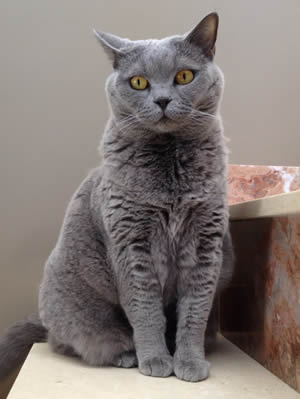Breed Standard
Head: Round, broad, and massive. Full cheeks. Distinctive muzzle. Short, broad, straight, nose with a gentle dip (but no nose break). Firm chin forming a perpendicular line with the nose.
Eyes: Large, round, and set wide apart. Color appropriate to coat color (copper, gold, blue, green, blue-green, odd eyed).
Neck: Short, thick, and muscular.
Body: Compact, well-knit. Broad chest, shoulders, and rump. Muscular.
Paw: Short and strong. Well boned and muscled. Round paws.
Tail: Length is equal to 2/3 the length of the body. Thick at the base and tapering slightly to a rounded tip.
Coat: Short, dense, and well bodied. Firm to the touch. Plush, giving the impression of natural protection. Abundant undercoat. British Longhairs also exist, the result of the introduction of too much Persian blood. All colors permissible. The British Blue is the most popular variety.
Fault: Overly fine head, jaws, or skull structure. Oriental eyes. Fine boning. Overlong coat. No undercoat. White lockets or buttons.
History
From rags to riches In the late 19th century, the Cheshire Cat of Lewis Carroll's (1865) Alice in Wonderland was depicted as a British Shorthair tabby. Around the same period, English breeders, including Harrison Weir, had begun selectively breeding the most beautiful street cats, which were shown for the first time at London's Crystal Palace in 1871. These cats were called British Shorthairs to distinguish them from foreign and oriental breeds and from longhaired breeds such as the Angora. The British Shorthair is the counterpart of the European Shorthair and the American Shorthair. In 1901, the British Cat Club was formed. The first British Shorthairs (mostly blues) resembled the Chartreux. As a result, the two breeds were crossed, to such an extent that the F.I.Fe decided to combine the two and recognize just one breed. But, in 1977, the F.I.Fe once again separated the two breeds and prohibited crossing of the two breeds. Following World War II, British Shorthairs were crossed with Persians to add mass and to fill out the British Shorthairs silhouette, as well as to increase the range of coat colors. New patterns, such as colorpoint, were recognized. In the United States, where the breed was crossed with American Shorthairs, the British Shorthair was recognized by the C.F.A. in 1980. The most recent standard established by T.I.C.A. was published in 1993. The French F.F.F. recognized the breed in 1979. British Shorthairs are extremely popular.
Behavior
This calm, good-tempered, easygoing cat looks like a teddy bear. British Shorthairs are excellent, well-balanced companions. The British Shorthair gets along well with other cats and dogs. He is lively, playful, and very affectionate, but not to the point of being bothersome. This breed is noted for its intelligence, loyalty and extending affection in a dignified manner. They won’t wow you by their speed, but they will win you over with their comical nature.This hardy breed does not reach full maturity until three to five years of age. Onset of puberty is relatively late. Weekly brushing and combing is sufficient. During shedding season (this cat sheds a lot), daily brushing is required.
Health
The two biggest health problems in the breed are Hypertrophic cardiomyopathy (HCM) and Hip Dysplasia (HD).






